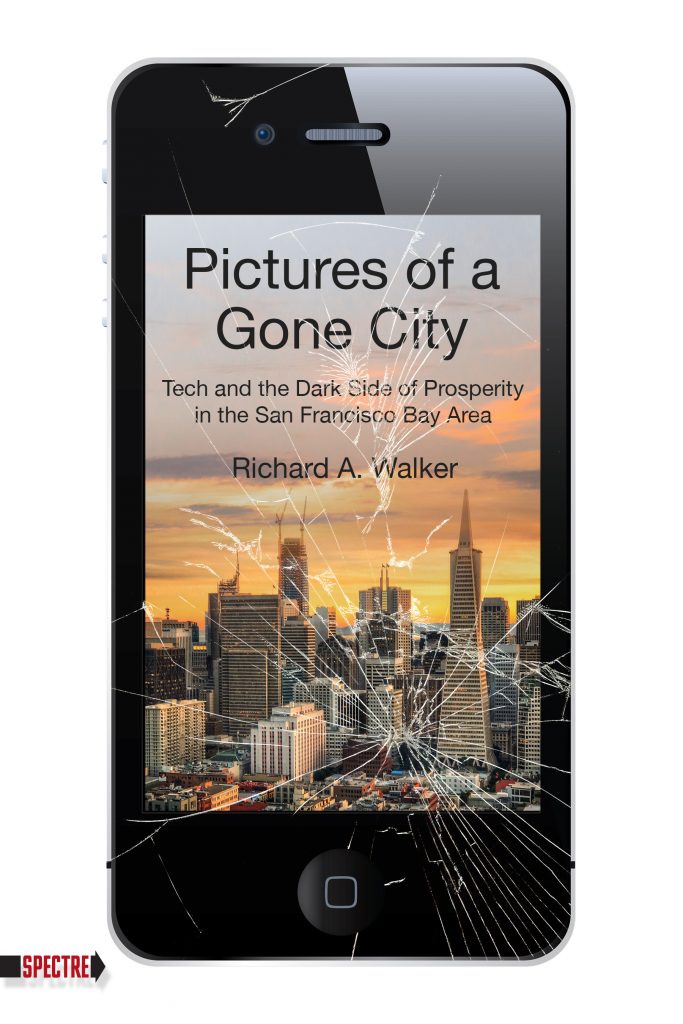By Kate Murphy
San Jose Mercury News
June 28th, 2018
The geographer Richard Walker is out with an unflinching examination of the San Francisco Bay Area, the epicenter of the tech boom — and he opens the book with a poem published more than a half-century before the iPhone:
“The world is a beautiful place / to be born into / if you don’t mind happiness / not always being / so very much fun / if you don’t mind a touch of hell / now and then / just when everything is fine / because even in heaven / they don’t sing / all the time,” it begins.
The work by Lawrence Ferlinghetti — “Pictures of a Gone World” — has always resonated with Walker, and it inspired the title of his new book: “Pictures of a Gone City: Tech and the Dark Side of Prosperity in the San Francisco Bay Area.”
The 394-page volume is both literally and thematically heavy, discussing the winners and losers of the latest tech boom along with themes of racial and economic segregation, displacement, urban sprawl, the foreclosure crisis and today’s housing crisis. The retired UC Berkeley geography professor said he wrote it with the “educated public” in mind, people “who want to figure out what’s going on” in this prosperous, yet turbulent time.
We caught up with Walker, who still lives part-time in Berkeley, about his latest book. This interview has been edited for length and clarity:
Q: What do you mean by “Gone City?”
A: There’s a book of poems by Lawrence Ferlinghetti, who opened City Lights bookstore and was one of the founding members of the beat movement in San Francisco in the early ‘50s. And there’s one poem in that collection that I have always loved. It speaks to the present reality. It speaks to the contradiction of living in a place that’s kind of fantastic — “gone,” in the lingo of the post-war era, meant good, but it also meant that it’s disappeared, a city that isn’t there anymore. Ferlinghetti’s poem speaks to that sense of being in a place and enjoying the life and the scene of a city as the writer moves through it, and at the same time having to step over homeless people. The poem is written in these couplets, of the world is a beautiful place if you don’t see the problems around you.
Q: There is one line where you talk about “the entire urban fabric being made over by forces beyond popular control and the powers of local government.” You write, “By the time it settles down again, the city will never be the same.” How so?
A: Having lived long enough and being an observer of this city since I was a teenager, I’ve been impressed, again and again, by the radical changes every decade or so. Every time there’s one of these major growth booms, the city is turned upside down. And then we forget. … We take the city again as normalized, we get used to it. And especially as young people come of age or people move into the Bay Area, you take the city as you find it and you think “Oh, that’s the way it’s always been.”
Q: You also take aim at a popular narrative that the fundamental problem behind the Bay Area’s high housing costs is artificially low housing supply, and that local restrictions on new development are largely to blame. Why is this wrong?
A: It’s wrong for a couple of reasons. It takes developers literally years to get a project off the ground, and that’s not the fault of regulation. It’s the reality of what it takes to assemble properties in a private market, to get financing, to get your architects and engineers and draw up the plans, organize your contractors, especially in a time where everyone wants contractors, and eventually get the darn thing built. Everybody knows it takes two, three, four, maybe five years. So the idea that a housing market can just respond like that if people get out of the way is nuts, it’s just completely false.
The second problem is that it ignores what’s going on right now, which is one of the greatest booms in the history of the Bay Area, in a city that is one of the most fast growing and the richest in the world. When you have a place that’s growing extraordinarily fast, extraordinarily rich, extraordinarily unequal and then to ignore all that and say, “Well the problem is the supply” — no, the problem is the demand, the demand generated by a boom, possibly a bubble, this extraordinarily high average income and enormous wealth at the top. In that kind of hot-house situation, prices rise very fast, there are extreme bottlenecks of supply that are generated by this exaggerated demand, and prices go through the roof.
Q: You also write that the housing crisis has produced a “flurry of policy debate and new legislation — most of which is based on erroneous ideas about how property markets work.” What do you mean by that?
A: This simple idea that if you just clobber all local governments and all local regulations, really come down hard on them, that will release this massive, pent-up supply, that’s what’s wrong. If you look at permitting in places like San Francisco or Berkeley you’ll find that there’s actually hundreds of permits for new units that are already approved but haven’t been built. It’s not like all local governments have been restraining the caged tiger of the developers.
Most local planning regulations actually make a lot of sense: Where are you going to build the building? How big is the building? Does it fit the neighborhood? … However it is true that there are a number of exclusive enclaves — like Palo Alto, Atherton, Orinda, most of Marin County — that could accommodate a lot more apartments and density, and they refuse.
Q: You predicted that the peak of the real-estate market would be in 2017, but prices are still going up. Will it be in 2018?
A: Looks like I’m wrong again. It peaked the first time in 2015, started softening in 2016, then it took off again in 2017 and there were signs of softening in 2018, but prices seem to still be going up. There have been repeated debates amongst economists and stock-market watchers over the the last three years about when is the next recession going to hit. Because it will, it always does — that’s the nature of capitalism, and there’s no getting away from it. The question is when?
Q: What do you make of the rent-control debate and the ballot initiative — which is eligible for the November ballot — to repeal Costa Hawkins, the state law restricting local policies?
A: Rent control is based on a battle between the class of renters and the class of property owners and landlords. There’s an awful lot of active intervention to drive up rents and transform who is living in these buildings, particularly in the very high-rent centers like San Francisco. Landlords are taking more money out of renters’ pockets every month. How do renters fight back? One way is politically, through rent control. When we had a movement in the ‘80s, the landlords went to the state with their very powerful lobbies and said we’ve got to cut these guys off at the knees, and that’s when they got Costa Hawkins in 1995. It was an effort to stop the rent control movement. It was a political battle that the landlords won in a much more conservative time, when California swung way to the right.
The point is not that rents don’t go up. It’s that you allow them to go up at a much more measured pace so that it keeps up with cost of living. You don’t put a lid on the market without a safety valve.
Q: Did you say you were a renter?
A: I have a rented house in West Berkeley. I have a very nice landlord — because there are some — who doesn’t raise the rent much. I’ve had some very good landlords. I’ve also had some crummy landlords in my day.
Q: What kind of reception has “Pictures of a Gone City” gotten?
A: It’s clearly hit a nerve. People are very engaged, very excited about a book that speaks to the problems that they see. Now, again, I don’t want people to get the wrong impression because this book is not simply a complaint. It’s about how important and dynamic and amazing this urban area is, and how vital it is to the world economy, especially the tech world.
Richard A. Walker
Age: 70
Hometown: Stanford
Education: Palo Alto High School, bachelor’s at Stanford University, Johns Hopkins for Ph.D
Career: professor of geography at Berkeley, teaching from 1975 to 2012
Family: one stepdaughter, age 41, one daughter age 25
Five things about Richard Walker
1. He splits his time between Berkeley and a village in Burgundy, France, where he owns a home.
2. His 25-year-old daughter lives with him in Berkeley because she can’t afford the rents.
3. He grew up at Stanford University in the 1950s and 60s and watched Santa Clara County turn into Silicon Valley — so his first scholarly project for his Ph.D was a study of the how and why of suburbanization.
4. He is “very old-stock American” who thinks this country was built on immigrants — his long-ago ancestors include a German who fought in the Revolutionary War.
5. He fell in love again at 70, “something I never thought would happen.”







